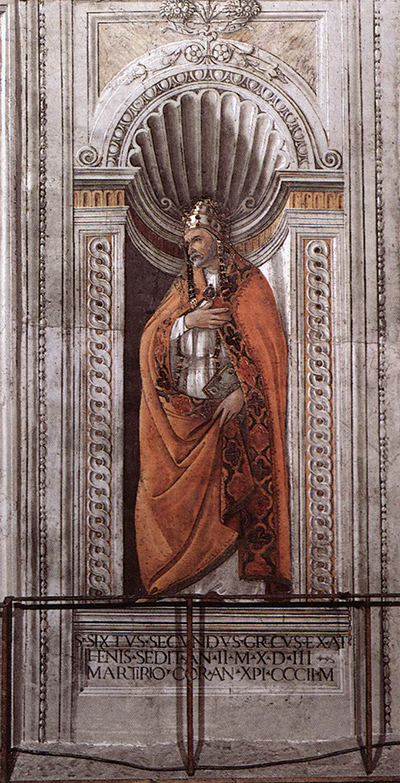Sixtus II is a fresco by Sandro Botticelli from 1481. It measures over two metres in height and just under a metre in width. It remains in the Cappella Sistina, Vatican, which we refer to as the Sistine Chapel. This building contains many of the most significant Renaissance artworks ever produced.
The artist would contribute a number of portraits within the Sistine Chapel of various early popes, with a number of other artists completing the rest. They all made use of the help of assistants to put these items together and over the years there has been some discussion over who completed which ones. We do know that Perugino, Ghirlandaio and Rosselli were also involved in this series, and that Botticelli himself was responsible for at least seven of the portraits. Several stylistic touches were very much a signature of the Florentine and so they could confidently be attributed to him, with Sixtus II being one of those. There is a large amount of artistic license used within these portraits, and even elements of architectural features were painted in to give an impression of stone work when viewing these items from a distance within the chapel.
Pope Sixtus II served from the year 257 to 258 AD before being succeeded by Dionysius. Sixtus II was originally a philospher and was actually Greek. Botticelli's depiction captures him in a red cape with traditional touches of detail that would have been worn at that time. The main attention of the artist here would have been around the clothing, with very little detail of the man himself actually displayed. He has a greying beard and peers off to his right, whilst holding his hand to his chest to hold his clothing in place. His other hand appears slightly below, to hold the other side of his clothing and there is also a large amount of jewellery painted into the design. Additionally, you will find patterns of stone work throughout the architectural reliefs which are placed behind each of these Papal portraits.
The Sistine Chapel hosts an extraordinary selection of art from the Italian Renaissance, with most of it installed directly onto the surfaces of the chapel itself. Efforts have been made continuously over the past few centuries to protect the artworks, with cleaning by hand helping to ensure that the original colours remain as bright as possible, despite the inevitable impact of light and pollution over the many years that have passed since these items were initially completed. Michelangelo, of course, left behind the greatest impact within the chapel, with two of his most famous creations being The Last Judgement as well as the truly iconic Creation of Adam which was placed on the ceiling. Assistants were necessary in order to complete the many different artworks that appear throughout this venue which remains one of the most visited venues in Italy even today.




